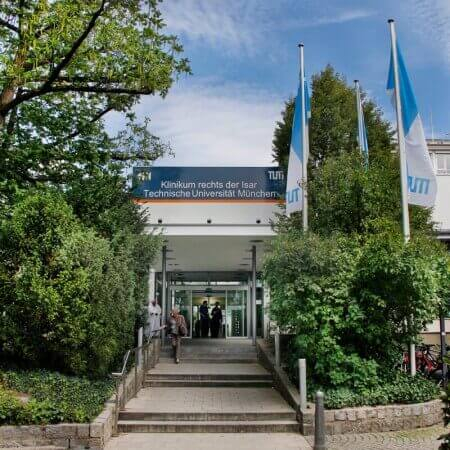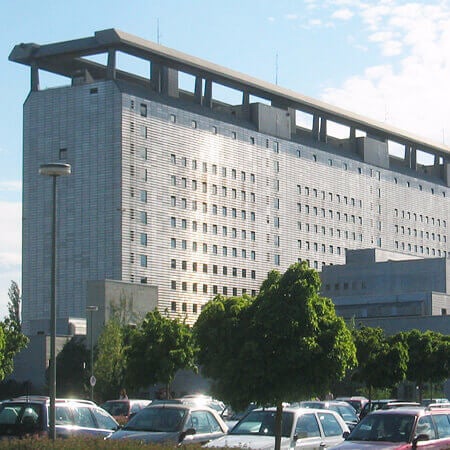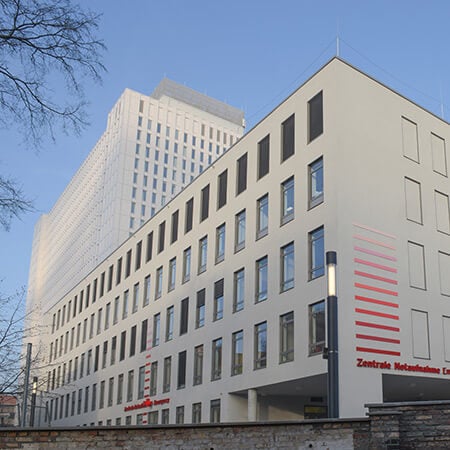Urolithiasis (Urinary stone disease)
Due to the difficulties associated with the organization of treatment in Turkey, Switzerland, South Korea and India, we are not currently processing requests to these regions.
If you are interested in treatment in Germany, please leave a request and our specialists will contact you as soon as possible.
Urolithiasis is a pathological process when calculi or stones appear in the kidneys and the urinary tract. It is the most common disease of the urinary system. Its prevalence is up to 3-5% of the population and even up to 10% in some countries. Over 50% of hospitalizations in the urological hospital are associated with urolithiasis.
The Booking Health portal presents 51 German clinics specializing in urolithiasis (urinary stone disease) treatment
Show all clinics
Urolithiasis – Diagnostics
Usually, a primary diagnosis is made when the patient visits a doctor in the case of renal colic. Laboratory tests data that confirm the diagnosis include:
- Urine рН changes
- Revealing salts in urine
- Macrohematuria (visible blood in the urine) or microhematuria (erythrocytes in urine)
- Bacteria and leukocytes excretion with the urine
- Leukocytosis and increased ESR in the blood
A kidney ultrasound or radiography of the abdomen performing is required to establish a diagnosis. Sometimes, both techniques are used at the same time, as each of them has its pros and cons.
Radiography can’t detect the X-ray negative stones with low density. These concrements are revealed by ultrasound, but ultrasound can’t scan the middle section of the ureter closed by the intestine.
Computed tomography (CT) is considered the best way to diagnose the illness. In the top clinics with high diagnostic capabilities CT is performed in all patients, but in most countries CT is still optional.
Computed tomography is performed when:
- There is coral nephrolithiasis
- A tumor is suspected
- A stone is not visualized with the help of ultrasound scan and radiography, but renal colic symptoms are present
It is important to determine the chemical composition of the stone for the selection of therapeutic tactics. Some calculi can be split up by certain medications and others respond to breaking with the ultrasound. There are also super solid stones, which can be either crushed directly or removed surgically.
The X-ray diffractometry and infrared spectrophotometry are used to determine the stone’s chemical composition.
Other diagnostic techniques are:
- Excretion urography is used to assess renal function
- Retrograde ureterography is used to assess the ureter patency
- Bacteriological culture of urine is done if inflammatory complications (pyelonephritis) are present
- Aortography is sometimes prescribed to patients with dendritic stones when planning surgical intervention
Best clinics for the urolithiasis diagnostics in Germany:
Urolithiasis – Treatment
Both conservative and surgical techniques are used for urinary stone disease treatment. Antispasmodics and pain-killers are prescribed if a patient is suffering from renal colic, but narcotic analgesics may often be required.
Further treatment purpose is to remove the calculi in one or the other way. Urate stones can be decomposed chemically with the help of special drugs that change the pH level of the urine. In addition, a patient has to drink a lot of water.
Radical treatment aimed at crushing or removing stones is used if the stones are larger than 1 cm, cause unpleasant symptoms or disrupt the function of the kidney. Surgical treatment is sometimes performed even when the calculi are small, about 4-6 millimeters, because of the following indications:
- Ineffectiveness of conservative treatment while symptoms remain
- Accompanying infectious process
- Chronic ureter obstruction (closure of its lumen)
Radical ways of urinary stone disease treatment are:
- Remote lithotripsy includes stones crushing with the help of acoustic waves. Then they go out on their own, or remnants of the concrements are removed ureteroscopically (through the urethra). Remote shock wave lithotripsy is used if the stone size is up to 2 cm.
- Contact ureterolithotripsy is used with the access through the urethra when a ureteroscope is inserted. The stone is crushed by various ways (laser, pneumatic, electrohydraulic measures). Then the concrements are extracted from the urethra. Extraction is not required when using the laser, because the stone turns into dust, and don’t split into fragments.
- Percutaneous lithotripsy is used for large stones, if they have a high density and are not subject to crushing with the help of an ultrasound, or in case of infectious complications and “impacted” concrements. This is a surgical operation when the stone is crushed and removed with the help of a tube inserted through a small incision in the lower back. The operation is minimally invasive and the rehabilitation period is short.
- Mini-percutaneous lithotripsy is a similar method, but it’s more modern and less traumatic. The tube is smaller, so the diameter of the cut can be only 0.5 cm long. The stone is extracted in parts by means of miniature surgical instruments.
Open and laparoscopic interventions are practically not used today. Stones are removed with the help of ureteroscopic methods or by percutaneous lithotripsy in 99% of the cases.
Best clinics for the urolithiasis treatment in Germany:

University Hospital Rechts der Isar Munich

University Hospital of Ludwig Maximilian University of Munich

Charite University Hospital Berlin
Urolithiasis – Rehabilitation
Rehabilitation in the case of urolithiasis helps the patient to restore normal urination and get rid of pain. Another important purpose is to prevent the formation of new stones in the kidneys.
The rehabilitation program includes the following aspects:
- Diet. Patients are recommended to consume 1.5-2 liters of fluid per day. It is preferable to eat the fiber-rich food (for example, nuts, legumes, cereals, vegetables, and fruits), as well as gentle ways of food processing.
- Physical exercises. When the stone in the ureter is revealed, a patient is recommended to do special therapeutic gymnastics. Physical activity helps the stone to get out without additional medical help.
- Health resort treatment. The healing mineral water, showers, baths, physiotherapy, mud applications, and massage have a beneficial effect on the kidneys condition. You can visit the health resort several times a year.
If necessary, the doctor complements the rehabilitation program with medicines. Medications dissolve the small stones, improve the movement of urine, and relieve pain.
In the case of urolithiasis, an individual and comprehensive approach for rehabilitation is used in German clinics. It guarantees a complete restoration of kidney function and life without relapse of the disease in the future.
Best clinics for general therapeutic rehabilitation in Germany:
Author:
The article was edited by medical expert, board certified Dr. Nadezhda Ivanisova. For the treatment of the conditions referred to in the article you must consult a doctor; the information in the article is not intended for self-medication!
Sources:
The cost of services includes
Here you can find the cost of treatment for this disease at the German University Hospitals. Leave a request and we will provide a free consultation with a doctor and will start organizing the whole treatment process.
The program includes the following:
- Issuing of an invitation for getting a visa for treatment as quick as possible
- Fixing an appointment at a time convenient for you
- Preliminary organization of a comprehensive examination and discussion of the forthcoming treatment plan
- Arranging transfer from the airport to the hospital and back to the airport
- Provision of interpreting services and services of a personal medical coordinator
- If necessary, assistance in the organization of further surgical treatment
- Provision of a medical insurance against treatment complications covering up to 200,000 euro
- Preparation and translation of medical records and recommendations from the hospital
- Assistance in the subsequent communication with your attending physician, including consultations on repeated X-ray images through the unique medical document management system E-doc


